Who would have thought? Yet that is what Giles Parkinson tells us in Myths of baseload and intermittent energy: It’s not what you think.
I’ll come back to that, but my reading of where we are landing with energy policy after the Dutton attempted putsch or insurrection is that the new cabinet Scott Morrison has put together is open to coal-fired power, but has no definite plans to build coal-fired power. So nothing is likely to happen, even in terms of concrete plans, prior to the election which must be held by 18 May next year.
This is evident in what Minister for Resources and Northern Australia Senator Matt Canavan said to Patricia Karvelas on Thursday. We have to remember that developing concrete plans to build a coal mine will take longer than the government has before the next election. Moreover, no private funding would be forthcoming and the likeliest government funding would be through the Northern Australia Infrastructure Facility (NAIF). However, the purpose of that fund is to stimulate and support private investment, plus I understand the Queensland government would have to sign off on the deal. Can’t see that happening.
However, new resources minister Angus Taylor signalled further taxpayer investment in existing coal and gas as reported by Katharine Murphy at The Guardian:
- In a clear nod to internal pressure, Taylor signalled on Thursday the government was intent on boosting supply, and that meant expanding existing plants, upgrading ageing “legacy” generators, as well as pursuing new “greenfield” projects.
“We need to encourage all of these,” he said. “It’s ironic that in a country with an abundance of natural resources – coal, gas, water and solar – we should be in this position.
“We need to leverage those resources, not leave them in the ground.”
Matthew Stevens in the AFR says that the Morrison government has simply given up on a broad energy policy that would provide a framework for future investment decisions and replaced it with a single “laser” focus on driving down energy prices:
“As the new Minister for Energy, my first and only priority is to reduce energy power prices,” Taylor said in introducing himself to a small business conference on Thursday. “And to do this while keeping the lights on.”
Needless to say, we count that as two quite distinct priorities, but there you go.
This graphic attempts to capture what Taylor is about:
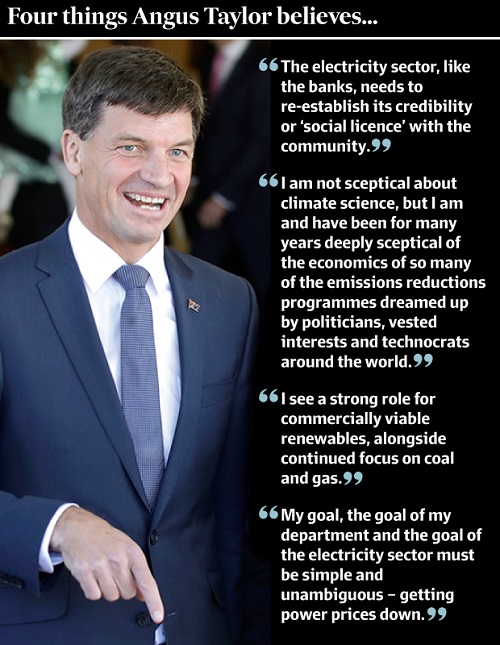
Stevens says Taylor’s policy priorities
remain blinkered by retail politics and that reflect an oddly un-Liberal belief that government knows better how to manage power markets than does industry.
Evidently we have a power price crisis even though as Taylor observed: “Electricity prices are turning the corner”. The government is claiming credit for this corner-turning which apparently is purely the result of government action and threat.
They claim credit for the reforms that have forced east coast gas exporters to fully supply the domestic market. Stevens said the prices did go down to three-year lows, but late in June they started to go up again to:
-
routinely hit trend peaks of $11-14 a gigajoule (GJ) and they were running at between $9.53 and $10.30GJ across east coast markets on Thursday with forward prices trending higher.
I think the key is that we are using less gas in the NEM, mostly using it to top up supply from coal and renewables.
Stevens says the retailers did indeed reduce prices in response to the government’s call, for which they were rewarded by being called “bandits”.
Stevens believes that Taylor’s “default” price is a misrepresentation of the ACCC’s “reference” price. The former will be tantamount to government price-fixing which is likely to make the situation worse.
Lately we have been hearing from diverse sources that electricity prices are falling, as reported by Peter Hannan and Cole Latimer in the SMH:
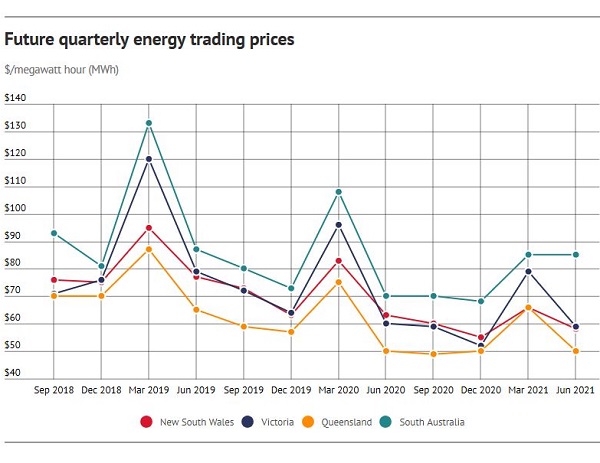
That’s irrespective of the NEG. And all that while the share of renewables is increasing:
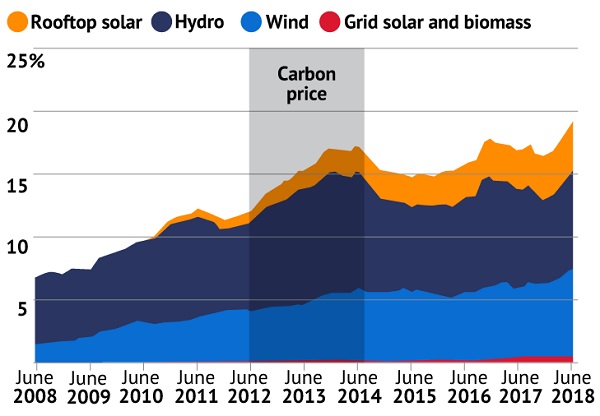
You may recall that the Finkel review forecast that renewables will bring prices down. In fact recently, in the middle of one day, solar power caused the price to go below zero in Queensland, although solar is just winding up in that state.
Katharine Murphy’s article quotes a Green Markets report by Tristan Edis:
The latest renewable energy index compiled by Green Energy Markets confirms analysis by the Energy Security Board that wholesale electricity prices are on the way down because of an addition of 7,200 megawatts of extra large-scale supply from renewable energy.
And:
-
The new analysis charts movements in prices in the energy market. It says prices began to rise when large amounts of supply were withdrawn from the market in South Australia with the closure of the Northern power station, and because of the closure of the Hazelwood plant in Victoria.
It says new investment in large-scale renewable energy projects during that period had stalled because of Tony Abbott’s efforts to wind back the renewable energy target. “It was only after prices began spiking upwards with the announced closure of Hazelwood that we saw significant commitments to construct new large-scale renewable energy supply.”
The analysis says price reductions have followed more renewable projects coming on stream. “Prices have since continued to decline in anticipation of increasing amounts of renewable energy supply reaching construction completion and contributing power to the grid.”
Edis himself is blunt about it – Turnbull was knifed by a lie: Renewables are already bringing prices down.
The AEMC (Australian Energy Market Commission) also predicts power prices to fall, but says it won’t last without proper policy. Historically the AEMC include the role of high gas prices in the rise of power bills, a factor often neglected.
Elsewhere in July the Australian Energy Regulator (AER) stripped $2 billion in revenue off the networks, whose charges make up at least half the bill paid by consumers.
Taylor says:
-
increases in power bills had “eroded the trust of Australians in the capacity of government and politicians to deliver affordable, reliable energy”.
“We need to re-establish this trust.” (Emphasis added)
The Fedral Government story here is that state politicians have erred in pursuing renewables based on green ideology, whereas federal politicians now need to intervene in the private enterprise market which is populated with “gougers” and “bandits” to restore trust.
I monitor selected company performance, and can tell you the AGL now has a prospective ‘return on equity’ (ROE) of about 11%. That is about half the average of other leading companies I follow, leaving aside the banks (which if included would bring the average down to about 17%).
In fact government policy is now firmly based on an alternative reality created by themselves.
In brief, the September 2016 blackouts are routinely blamed on renewables, whereas a ruddy great storm blew down 22 power pylons. In the cold start for the network south of the wrecked grid, wind came on before gas.
In the subsequent summer there was a blackout in a few suburbs in Adelaide, garden variety in terms of what we experience in SEQ every summer, again blamed on renewables. In fact AEMO, the market operator, got the forecasts wrong that day in terms of temperature, demand, and the degree to which wind dropped in early evening. The result was they called in a gas power station, sitting by idly without even a supply of gas available, minutes before it was required instead of hours.
That was after the previous CEO of AEMO had retired and before Audrey Zibelmann took up duty.
When the heatwave hit NSW, AGL preferred to ask Tomago smelter to close for a short time rather than inconvenience domestic consumers on a Friday afternoon/early evening.
Subsequently it was found that several coal-fired power stations malfunctioned in the heat and solar actually helped the situation.
On the Sunday evening the brutal heat hit SEQ, where there were rolling blackouts for about four hours which were not reported anywhere in the mainstream media. What happened is that demand reached record and unpredicted levels which had two consequences. First there were spikes in the spot market price, and five coal-fired power units failed.
To this day the former stands as evidence of Qld power generators ‘gaming the system’, whereas an AER investigation published in May told the truth as oultlined above.
Josh Frydenberg even says he called out the Qld rogue operators which were then reigned in by the Qld government. He did no such thing.
Quite separately in early June Mark Bailey, the relevant Qld minister, wrote to Stanwell, along with CS Energy a government generator which together supply two-thirds of the market, directing them to change their bidding strategy.
CS Energy and Stanwell operate with two conflicting aims – to provide affordable power to Queenslanders, and to provide revenue so that the government can pay for schools hospitals and other infrastructure and services. Very simply, Stanwell had the balance wrong. I understand NSW private coal operators who were effectively setting the market price at the time, allowing Stanwell to lift their prices.
In any case the futures price, which has a fair bit of sentiment and guesswork in it, dropped by 25%. This was a result of Queensland action, the Feds had nothing to do with it.
Now Giles Parkinson has come up with two remarkable articles on 29 August:
The spinmeisters in Canberra have been spruiking the need for reliable ‘baseload’ energy, basically coal supplemented by gas, which they are confusing with dispatchable energy, dispatchable with minutes notice, which coal is not.
In terms of reliability, we’ve had more than 100 trips of big fossil fuel plants since last December, often at times of soaring heat.
In terms of intermittency, the spinmeisters have been spruiking ‘synchronous’ generators, by definition coal and gas.
At a recent seminar Kate Summmers, one of the country’s leading electrical engineers, has turned the whole issue on its head.
You see, no-one checks whether the ‘synchronous’ generators actually supply synchronous power under stress. She says, they are actually more likely to transgress the operating bandwidth than wind or solar.
Those with the requisite skills can look at the detail, but the simple story is contained in this graph of what happened in NSW in February 2017:
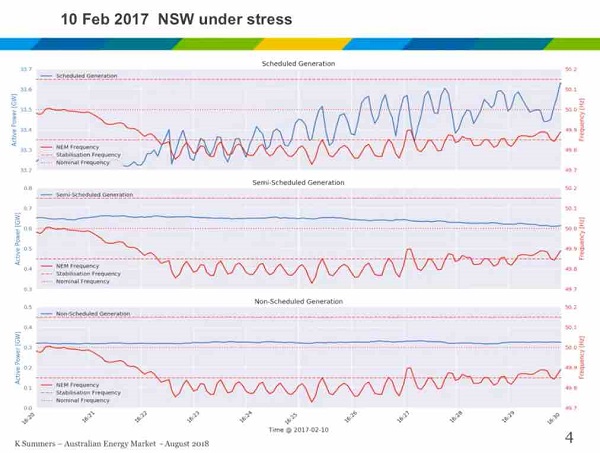
Wind and solar are the blue lines in the second and third graphs.
Taylor says he is looking to base policies on the “truth”. He should go to those who know, which seems to exclude many who have plenty to say, as well as some operating in the industry.

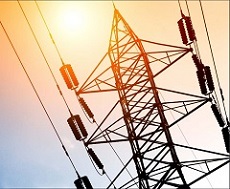
Brian,
See my comment on another thread re Professor Blakers’ ANU team winning a 2018 Eureka Prize.
I was composing my comment as you posted above.
Brian, you say:
You may be right, but the domestic gas supply from the eastern states won’t last forever.
Check out the AEMO’s earlier GAS STATEMENT OF OPPORTUNITIES FOR EASTERN AND SOUTH-EASTERN AUSTRALIA, published April 2015. On page 7 of the report Figure 2: Depletion of proven and probable conventional gas reserves shows existing developed gas reserves would be depleted by about 2029.
And BP Statistical Review of World Energy 2018 shows on:
page 26: US proved gas reserves-to-production (R/P) at the end of 2017 was 11.9 years;
page 28: US was world’s largest gas producer in 2017, at 20.0% global share;
page 29: US was world’s largest gas consumer in 2017, at 20.1% global share.
I can’t see the rest of the world making up shortfalls in supply when the US inevitably begins a sustained decline in gas production (probably in the next few years). That means the world will be heading into a post- ‘peak gas’ world. That means humanity must leave fossil natural gas, before gas leaves us.
But why develop more (and probably more expensive) gas reserves? We have no more carbon emissions budget remaining and cannot burn more gas unless we wish to cook the planet.
Thanks, Geaoff. We should here more about Prof Blakers, pumped hydro, and improved network connectivity.
Solar towers with back-up molten salt heating , hydro power and other renewables combined with storage can all be used to provide baseload power. In addition, keep in mind that part of the output from other renewables plus storage can be considered baseload. (“Baseload” = the minimum amount the system can provide.)
Baseload coal is not dispatchable because it takes too long start up and has limited flexibility. The renewable power option listed above are far more dispatchable.
While a single solar panel or windmill may have a rapidly varying output solar and wind spread over a large area and connected by the grid have an output that changes very slowly with weather forecastes providing a prediction of longer term variation.
The public deserves to hear more about Prof Blakers’ work.
Here, we already hear about it.
With thanks to Brian, John, BilB, Geoff and Geoaff.
John Davidson (Re: SEPTEMBER 3, 2018 AT 1:36 PM):
SolarReserve’s Submission (#246) to the NSW Legislative Council Select Committee on Electricity Supply, Demand and Prices in NSW has just become publicly available this afternoon.
It would not be there now if I had not drawn SolarReserve’s attention to the inquiry.
Ambigulous Re: SEPTEMBER 3, 2018 AT 3:36 PM):
The Eureka Prize will help. It was mentioned on ABC RN Science Show, but spread the word.
Ambigulous (Re: SEPTEMBER 3, 2018 AT 3:36 PM):
I’ve referred to Blakers’ work in a question on the ABC Q&A Latest Questions webpage. My question was lodged at 03 Sep 2018 11:40:25am.
Spreading the word.
GM, admirable persistence, but does anyone read those threads?
Professor Ian Chubb is an outstanding public advocate for scientific knowledge. He speaks clearly and trenchantly.
I think I just heard him addressing the National Press Club (ABC News Radio).
Cheers
Brian (Re: SEPTEMBER 4, 2018 AT 10:21 PM):
I use it as a ‘drop box’, then phone/message specific people.
Today, I rang the offices of Steve Ciobo and Anthony Albanese (they were panelists on last Monday night’s show) to draw attention to the info contained in the questions, hopefully to get them thinking about some of the critical issues that I see facing Australia (population growth, climate change existential risk, energy security, water security). And some other people.
As for your question about whether there’s anyone reading the thread – someone at the ABC is reading them because the lodged questions are vetted before being published. Hopefully, some of this information gets passed on for further investigation, but I don’t see any evidence of it filtering through to ABC reporting.
I lodged 8 questions on Monday – 7 were published. I don’t know why one question was knocked-back and not published – I don’t think it was defamatory, derogatory or incited illegal acts. But 7 questions made it through and I hope at least some people see it and gets them thinking (and acting on it).
It’s about raising awareness, and hopefully precipitating action with decision-makers.
Brian, have you got any better ideas?
My answer: Brian runs an excellent blog, and puts in huge efforts researching relevant topics.
I now find that the National Press Club today hosted Heather Ridout, Prof Ian Chubb and Prof Anne Tiernan.
Topic: “Rebooting Democracy”.
(a subject dear to the hearts of many readers and posters here).
The session will be re-broadcast on ABC TV very early tomorrow (6th Sept.), at least that’s the schedule in Vic.
Transcripts may be purchased, at an outrageous price.
Today on RenewEconomy, Giles Parkinson has posted an article headlined Taylor says there is too much wind and solar in electricity grid.
Alan Jones had ScoMo in his studio on Monday, podcast here. Comments made by AJ between time intervals 08:48 and 09:05, prompted me to send AJ feedback on Monday afternoon as follows:
Ambigulous (Re: SEPTEMBER 5, 2018 AT 5:01 PM):
I’m not disputing “Brian runs an excellent blog, and puts in huge efforts researching relevant topics.” But that doesn’t answer my question to Brian.
How many people see Brian’s blog? Who are they? Are they likely to influence the required change?
I suspect there may be more people that view the Q&A website than Brian’s blog.
I’m engaging with decision-makers. What are you doing?
Thanks for that Edis link.
The Anti-Renewables Faction are a serious threat to our democracy – if they can bring down a Prime Minister, what else that is worse can they do? Are they this generation’s Thirty-Six Faceless Men? (Oh alright, Gina’s in there too)
I have the impression that some of their arguments are similar to those of the Pro-Slavery enthusiasts of two centuries ago.
You never know exactly what is going on under the surface, GM.
I would say the rising uptake of rooftop solar by households and small businesses, shows a widespread acceptance of affordable renewable electricity; indeed, people advocating adoption amongst friends, family (and what is the $ value of publicity that visible rooftop panels send out every day?)
So the persuasion is going on all over the country, and installers (large and small) are prospering. The owners of the panels become interested in feed-in tariffs, RECs, local power-sharing proposals; and dare I suggest, they take more notice of large-scale solar and wind farm proposals. I hazard a guess that very few domestic customers examined their electricity bills carefully, before they became very keen on feed-in credits or cost reductions through their own generation.
The take-up figures are public knowledge, the changing of minds is partly under the radar I think.
Now you may say these are small changes, and too slow. I agree. Electricity is “the low-hanging fruit” in emissions reduction.
But politicians and policy experts listen. Eventually they realise they can’t be left behind by a profound social change. An MP dreads becoming a stranded asset.
I am old enough to recall The Change in Eastern Europe sweeping two gentlemen into power: the most unlikely, the Sovietologists of that era would have opined…..
Lech Walesa, an humble electrician.
Vaclav Havel, a “dissident playwright”, harassed by the authorities.
Electrician?
Scribbler??
What were the odds?
Well, it seems (with the benefit of hindsight) that huge numbers of people had been quietly unhappy about authoritarian rule, Soviet occupation, lies, restrictions on freedom, empty promises, and backward factories and shoddy everyday goods.
It strikes me that Press reporting in those days in Australia focussed on ‘leaders’: Ulbricht and his mediocre puppet comrades across Eastern Europe, and on diplomatic and military manoeuvring. Understandable in the shadow of nuclear war, but so inadequate while the magma of discontent was down below the surface, strongly rising, ready to emerge in the eruptions of 1989.
I am interested in social change, as you can see, but believe it can be a very complicated (and unpredictable) process…..
PS: another anecdote, this time from modern China. Gereme Barme, an Australian student of China, was lucky enough to be in China on the day Mao’s death was announced. He saw a history teacher tearing some pages out of a published history textbook.
My guess: many in Australia would have believed in 1976 that the Chinese Govt had 100% control over information and knowledge. Not so. The teacher was aware of lies, and knew which pages he should throw in the bin. Long live private conversations, and resistance to bullsh*t !!!
BTW
I am not suggesting that our Australian polity resembles Eastern Europe during 1948 – 1989, or China from 1949, or 1920… to …. well, 2018.
Nicholas Stern on RN with Fran this morning:
“Managing the transition (to renewable energy) and doing it slowly are not the same thing!”
New post now up – Reconnecting climate politics with reality.
Graham Bell (Re: SEPTEMBER 6, 2018 AT 7:05 AM):
Worse. By delaying the rapid transition to renewables they (and their ilk around the world) likely risk humanity’s extinction (i.e. that includes you and me and the people we care about).
In What Lies Beneath: The Understatement of Existential Climate Risk, by David Spratt and Ian Dunlop, revised/updated Aug 2018, it states on page 40:
The questions you need to ask yourself:
Do you want to take the risk that Spratt and Dunlop are wrong, and ignore the warnings?
If you accept that Spratt and Dunlop may be close to the mark, and urgent effective action is required to mitigate the problem, are you going to contribute in a meaningful way, in an attempt to change the current paradigm (given the information highlighted on the CP website), or are you going to sit back and do nothing (hoping someone else will do it for you)?
I put to you: No one is exempt from the risks – we are all in this together on spaceship Earth.
Make use of the knowledge you have and do something beneficial with it. Spread the word where it counts.
Geoff Miell (11:44am 6 Sept.):
I do what I can. Sadly, my meagre efforts are hindered, not only by the propaganda machine of the pro-coal clique – but by the failure of the advocates of responsible energy production to even think about the social consequences of closing coal mines and coal-fired power stations. How can all those workers transition seamlessly and painlessly into beneficial alternative employment?
If you want a fine example of what not to do, look at Senator Graeme Richardson’s hit-and-run raid on the North Queensland timber industry a couple of decades ago. The capital city “screaming greenies” got their transient smuggery fix whilst hundreds of honest workers were dumped onto the dole. Let’s not repeat that social disaster, please.
Ambigulous:
That same unpredictable lake of magma is welling up under Australia now – and the “thirty-six faceless men” of the Anti-Renewables Faction will soon find out what a pyroclastic flow is.
b.t.w. I did like your, “The teacher was aware of lies, and knew which pages he should throw in the bin.” Yay! Someone after my own heart!
Graham Bell (Re: SEPTEMBER 7, 2018 AT 7:52 AM):
Why do you say that? The unions recognize the inevitable. Some local government councils, in areas where coal mining and coal-fired power stations dominate the economy, recognize that a just transition is required – see the testimony of Mayor Martin Rush of Muswellbrook Shire Council at the public hearing conducted by the Australian Senate Environment and Communications References Committee on the Retirement of coal-fired power stations (from page 10 of the hearing transcript) that includes:
Other organisations still have their proverbial heads in the sand.
Some people are thinking about the transition. See Implementing coal transitions: Insights from case studies of major coal-consuming economies: A Summary Report of the Coal Transitions project. From page 27 of this report is Section 4. A “just transition” for workers and citizens is possible.
It’s up to us (as citizens) to insist that governments ensure a just transition.
It’s not just ensuring a just transition for fossil fuel industry workers – the bigger picture is humanity’s survival. What do you think is the more pressing and more difficult challenge?